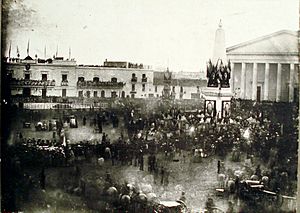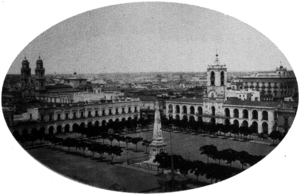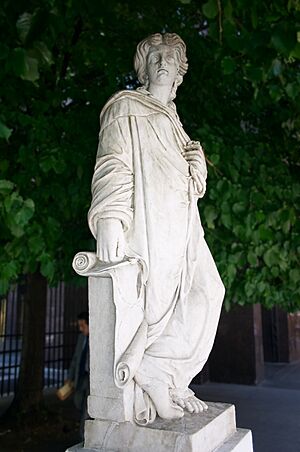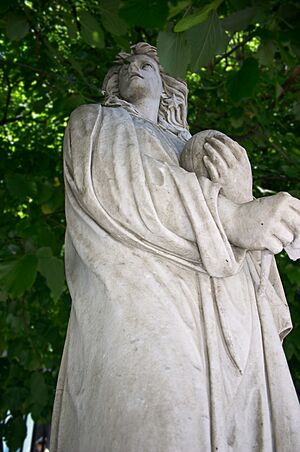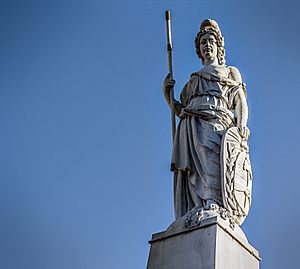Pirámide de Mayo facts for kids
The Pirámide de Mayo (which means "May Pyramid") is the oldest national monument in Buenos Aires, Argentina. You can find it right in the middle of the Plaza de Mayo. It was built in 1811 by the Primera Junta (the first government of Argentina) to celebrate the first birthday of the May Revolution. This revolution was a very important event that started Argentina's journey to independence.
The monument was updated in 1856 by Prilidiano Pueyrredón. Later, in 1912, it was moved 63 meters (about 69 yards) to the east. The idea was to build a much bigger monument around it, but that never happened.
At the very top of the Pyramid, there is a statue representing Liberty. This statue was made by the French artist Joseph Dubourdieu. From the ground to the top of the statue's hat (called a Phrygian cap), the Pyramid stands 18.76 meters (about 61.5 feet) tall.
Contents
Building the Pyramid
On April 5, 1811, the city council of Buenos Aires (called the Buenos Aires Cabildo) decided to build a pyramid. This was part of the celebrations for the first anniversary of the May Revolution. No one knows for sure why they chose a pyramid shape. Some people think it was inspired by pyramids carved into pillars in Paris.
Back then, the Plaza de Mayo was split into two smaller squares by an old archway. The Pyramid was built in the center of one of these squares, called the Plaza de la Victoria.
Architect Pedro Vicente Cañete and sculptor Juan Gaspar Hernández insisted that the monument should be made of solid materials, like 500 bricks, instead of wood. On April 6, they poured the foundation cement with lots of music and celebration.
The Pyramid was officially opened on National Day, even though it wasn't completely finished yet. It was decorated with flags from different military groups in Buenos Aires. The Pyramid and the Cathedral were lit up with many lights. The celebrations lasted four days and included dancing, games, and even freeing some slaves.
The original Pyramid was made of baked adobe (a type of brick) and was about thirteen meters tall. It had a simple base and was topped with a decorative globe. A railing with twelve pillars surrounded it, and lanterns hung from poles at each corner. On holidays, the Pyramid was decorated with banners and paper lanterns.
In 1826, President Bernardino Rivadavia wanted to build a new, grander monument. There was a debate about whether to replace the Pyramid. However, Rivadavia resigned, and the project was never completed.
In 1852, the Pyramid was lit up with gas lights, which amazed the public who were used to small oil lamps.
The Big Renovation
By 1856, the Pyramid was looking a bit old and worn out. The artist and architect Prilidiano Pueyrredón was asked to restore it. He decided to make it more artistic and impressive. The new pyramid was built right over the old one, using bricks to create a strong base.
The statue of Liberty, wearing a Phrygian cap, was placed on top. This statue is 3.6 meters (about 11.8 feet) tall and was made by the French sculptor Joseph Dubourdieu. He also created four other statues representing Industry, Commerce, The Sciences, and The Arts. These were placed at the four corners of the Pyramid's base.
The side of the Pyramid facing the Casa Rosada (the presidential palace) was decorated with a golden sun. The other three sides have laurel wreaths carved into them. Pueyrredón also made the base taller and wider. Each side of the base was decorated with the national coat of arms. A new fence was built, and a gaslight was placed at each corner.
Over time, the statues made by Dubourdieu started to wear out. In 1873, they were replaced with four new statues made of Carrara marble. These statues represented Geography, Astronomy, Navigation, and Industry. They were later moved in 1912 and then again in 1972 to a different square. However, in 2018, these statues were brought back to their original spots at the corners of the Pyramid.
In 1883, the old archway that divided the Plaza de Mayo was torn down. This joined the two smaller squares into the single Plaza de Mayo we know today. There was talk of tearing down the Pyramid to build an even grander monument. However, this idea was not carried out, and the Pyramid stayed.
Moving the Pyramid
In 1906, as the 100th anniversary of the May Revolution approached, there were plans to build a huge new monument that would completely surround the Pyramid. This meant the Pyramid had to be moved to the center of the Plaza de Mayo. This move finally happened in 1912.
First, the marble statues were removed. Then, the Pyramid was covered in wood for protection. Special rails were laid down, and a cement platform with strong wheels was placed underneath the Pyramid. Between November 12 and 20, the Pyramid was carefully pulled 63.17 meters (about 69 yards) using a winch. A metal box with information about the move was buried under its new foundation.
Even though the move was successful, the bigger monument that was supposed to surround the Pyramid was never built. Many people hoped the Pyramid would be restored to its original look.
On May 21, 1942, the Pyramid was declared a historical monument. Later, in 2005, the area around the Pyramid also became a historical site. This area is famous for the sidewalk paintings of shawls, which represent the Madres de Plaza de Mayo (Mothers of Plaza de Mayo). On December 8, 2005, the ashes of Azucena Villaflor, the founder of this organization, were buried at the base of the Pyramid. This was where she had organized her first protest.
The Commemorative Plaque
On the west side of the Pyramid, there is a bronze plaque. It has two names written on it: Felipe Pereyra de Lucena and Manuel Artigas. Most people who visit the Pyramid don't know these names. They were added in 1891 to honor the first two military officers who died fighting for Argentina's independence.
- Manuel Artigas was born in 1774 in Montevideo. He was part of a revolutionary group. He showed great bravery during a military campaign in 1811 and was wounded on April 25. He died on May 24 at the age of 33.
- Felipe Pereyra de Lucena was born in 1789. He fought in the British invasions of the Río de la Plata and later became a lieutenant. In 1811, he was promoted to captain. He was wounded in what is now Bolivia and died on June 20 at the age of 22.
When news of their deaths arrived, the government decided to honor them by putting their names on a bronze plaque. However, they didn't have enough money at the time. It took many years and a public collection of funds before the plaque was finally installed on May 24, 1891.
Images for kids
See also
 In Spanish: Pirámide de Mayo para niños
In Spanish: Pirámide de Mayo para niños
- Buenos Aires
- Buenos Aires (Landmarks)



